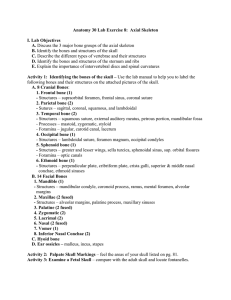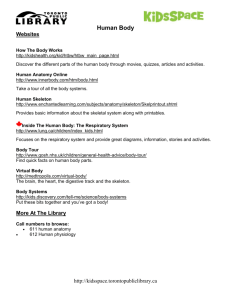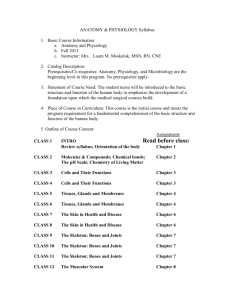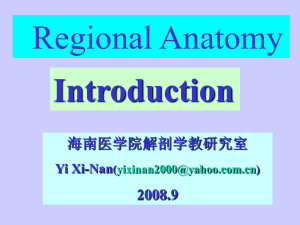Lab 10 Axial Skeleton
advertisement
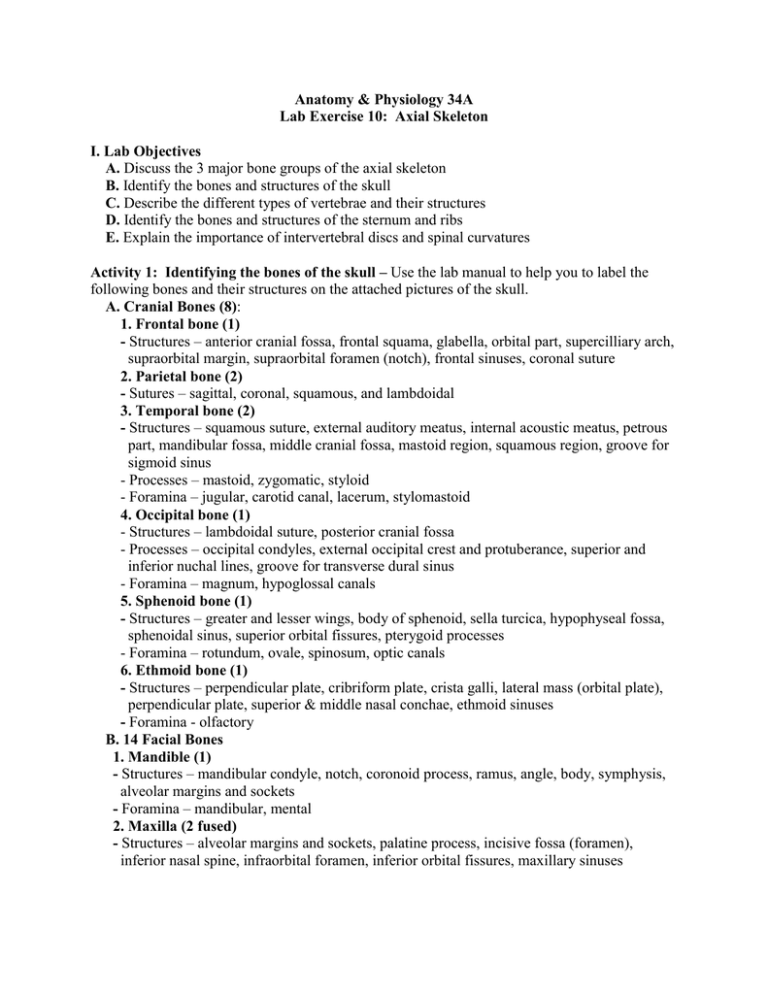
Anatomy & Physiology 34A Lab Exercise 10: Axial Skeleton I. Lab Objectives A. Discuss the 3 major bone groups of the axial skeleton B. Identify the bones and structures of the skull C. Describe the different types of vertebrae and their structures D. Identify the bones and structures of the sternum and ribs E. Explain the importance of intervertebral discs and spinal curvatures Activity 1: Identifying the bones of the skull – Use the lab manual to help you to label the following bones and their structures on the attached pictures of the skull. A. Cranial Bones (8): 1. Frontal bone (1) - Structures – anterior cranial fossa, frontal squama, glabella, orbital part, supercilliary arch, supraorbital margin, supraorbital foramen (notch), frontal sinuses, coronal suture 2. Parietal bone (2) - Sutures – sagittal, coronal, squamous, and lambdoidal 3. Temporal bone (2) - Structures – squamous suture, external auditory meatus, internal acoustic meatus, petrous part, mandibular fossa, middle cranial fossa, mastoid region, squamous region, groove for sigmoid sinus - Processes – mastoid, zygomatic, styloid - Foramina – jugular, carotid canal, lacerum, stylomastoid 4. Occipital bone (1) - Structures – lambdoidal suture, posterior cranial fossa - Processes – occipital condyles, external occipital crest and protuberance, superior and inferior nuchal lines, groove for transverse dural sinus - Foramina – magnum, hypoglossal canals 5. Sphenoid bone (1) - Structures – greater and lesser wings, body of sphenoid, sella turcica, hypophyseal fossa, sphenoidal sinus, superior orbital fissures, pterygoid processes - Foramina – rotundum, ovale, spinosum, optic canals 6. Ethmoid bone (1) - Structures – perpendicular plate, cribriform plate, crista galli, lateral mass (orbital plate), perpendicular plate, superior & middle nasal conchae, ethmoid sinuses - Foramina - olfactory B. 14 Facial Bones 1. Mandible (1) - Structures – mandibular condyle, notch, coronoid process, ramus, angle, body, symphysis, alveolar margins and sockets - Foramina – mandibular, mental 2. Maxilla (2 fused) - Structures – alveolar margins and sockets, palatine process, incisive fossa (foramen), inferior nasal spine, infraorbital foramen, inferior orbital fissures, maxillary sinuses 2 3. Palatine (2 fused) - Structures – horizontal plate, perpendicular plate 4. Zygomatic (2) - Structures – temporal process, zygomatic arch 5. Lacrimal (2) -Structures – lacrimal fossa 6. Nasal (2 fused) 7. Vomer (1) 8. Inferior Nasal Conchae (2) C. Hyoid bone - Structures – body, greater and lesser horns D. Ear ossicles – malleus, incus, stapes Activity 2: Palpate Skull Markings – feel the areas of your skull listed on pg. 132. Anatomy & Physiology 34A Lab 10: Axial Skeleton - Skull Models Label the structures listed in the lab handout on the skull models below. You can find the names of the numbered structures on the Penn State Anatomy website (http://www.bio.psu.edu/people/faculty/strauss/anatomy/skel/skeletal.htm), as well as the lab manual, textbook, and our lecture modules. Note that these Penn State Anatomy skeleton pictures have more structures than I am requiring you to label. You only need to label what’s on our handout. Have fun! Anterior view Lateral view 4 Inferior view (mandible removed) Internal cranial floor view (skull cap removed) Activity 3: Examining Spinal Curvatures – observe the 3 types of abnormal spinal curvatures in Figure 10.1 on pg. 133, and answer the questions. Compare and contrast with normal spinal curvatures: cervical, thoracic, lumbar, and sacral. Activity 4: Examining Vertebral Structure – observe an articulated vertebral column, as well as a sacrum, coccyx and individual cervical, thoracic, and lumbar vertebrae. Use the lab manual to help you to label the following on the attached vertebra pictures. - Typical vertebrae structures – centrum (body), vertebral foramen, spinous process (1), transverse processes (2), superior & inferior articular processes with facets, superior & inferior notches, lamina, pedicle, vertebral arch, intervertebral foramina - Key Cervical vertebrae structures: ________________________________________________ Atlas (C1) lacks a body, has transverse processes with foramina, and superior and inferior articular facets, anterior arch and tubercle, lateral masses. Axis (C2) has a body and an odontoid process (dens) Vertebra prominens (C7) has the longest spinous process. - Key Thoracic (T1-T12) vertebrae structures: _______________________________________________ - Key Lumbar (L1-L5) vertebrae structures: _________________________________________ - Sacrum – 5 fused vertebrae, articulates with ilium at auricular surfaces. Structures – apex, anterior and posterior sacral foramina, base, bosy, lateral and medial sacral crests, sacral canal, ala, sacral promontory, superior articular processes, transverse ridges (lines) - Coccyx – 3-5 fused bones - Intervertebral discs Activity 5: Examining the structures of the rib cage – label the following on the attached rib cage pictures. - Sternum structures– manubrium, clavicular and jugular notches, sternal angle, body, xiphisternal joint, xiphoid process - Rib structures – head, neck, tubercle, angle, body (shaft), costal cartilage on costal end, coastal groove and margin - Describe the following: True ribs False ribs Floating ribs Activity 6 (supplement): Examine a Fetal Skull – compare with the adult skull and locate the fontanelles (SPAM = sphenoid, posterior, anterior, and mastoid), cranial bones (frontal, parietal, occipital, temporal), and sutures (coronal, squamous, sagittal, and lamdoidal) 6 Anatomy & Physiology 34A Lab 10: Axial Skeleton – Vertebra Models Label the structures listed in the lab handout on the vertebra models below. You can find the names of the numbered structures on the Penn State Anatomy website (http://www.bio.psu.edu/people/faculty/strauss/anatomy/skel/skeletal.htm), as well as the lab manual, textbook, and our lecture modules. Note that these Penn State Anatomy skeleton pictures may have more structures than I am requiring you to label. Atlas (C1 cervical vertebra) Thoracic vertebra Axis (C2 cervical vertebra) Lumbar vertebra Sacrum 7 Anatomy & Physiology 34A Lab 10: Axial Skeleton – Rib Cage Label the structures listed in the lab handout on the rib cage models below. You can find the names of the numbered structures on the Penn State Anatomy website (http://www.bio.psu.edu/people/faculty/strauss/anatomy/skel/skeletal.htm), as well as the lab manual, textbook, and our lecture modules. Note that these Penn State Anatomy skeleton pictures have more structures than I am requiring you to label. You only need to label what’s on our handout. Have fun! Sternum Rib Cage (anterior view) Rib Rib & Vertebra Homework: Complete the Lab 10 Review Sheets.
